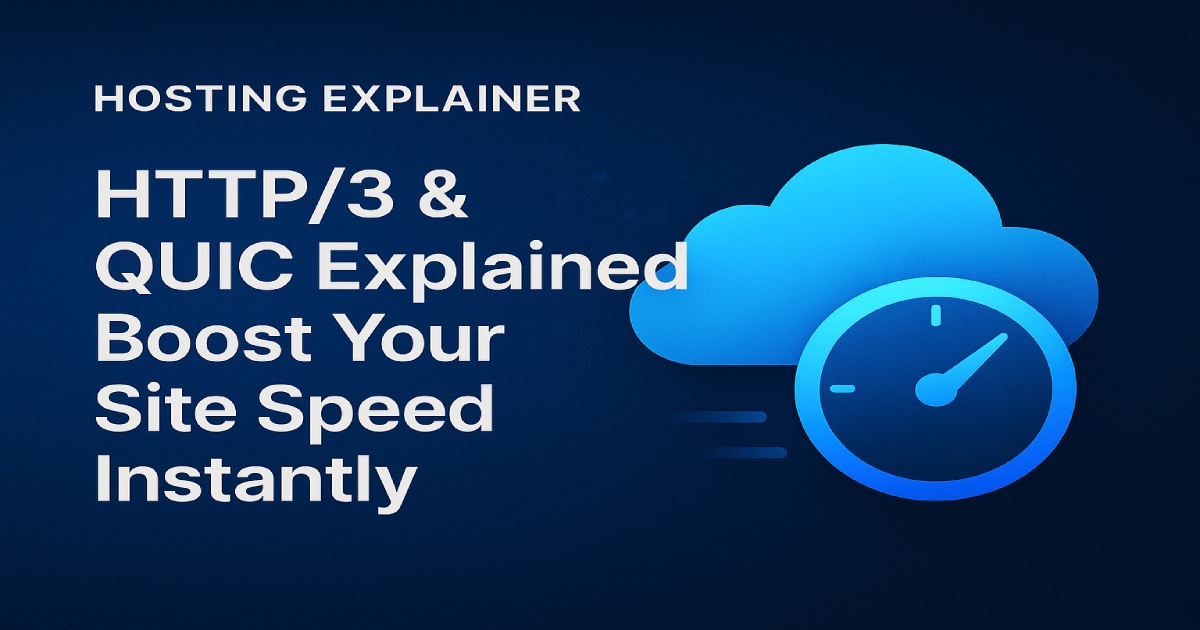HTTP/3 & QUIC Explained: Boost Your Site Speed Instantly
Do you remember when websites used to take forever to load? I do. Back then, we accepted slow speeds as normal. Today, even a two-second delay feels unbearable.
Speed is no longer a luxury. It is a user expectation and a ranking signal. That is why HTTP/3 and QUIC have become hot topics. These new web technologies are changing how data travels across the internet.
In this article, I will explain what HTTP/3 and QUIC are, how they work, and why they matter for site speed, SEO, and user experience. I will also share how you can enable them on your website and stay ahead in a fast-moving digital world.

What Is HTTP/3, and How Does It Work?
HTTP/3 is the newest version of the Hypertext Transfer Protocol, the foundation of how browsers and servers communicate. Unlike older versions, it no longer depends on TCP, or Transmission Control Protocol. Instead, it uses QUIC, which runs on a faster, more modern system called UDP.
Why is that important? Because UDP does not make data wait for every handshake or confirmation before continuing. It sends information more directly, which reduces delay and makes websites load faster.
Here is a simple comparison that shows how far we have come:
| Protocol | Base | Speed | Encryption | Head-of-Line Blocking | Mobile Stability |
|---|---|---|---|---|---|
| HTTP/1.1 | TCP | Slow | Optional | Yes | Weak |
| HTTP/2 | TCP | Faster | Built-in | Still an issue | Improved |
| HTTP/3 | UDP (QUIC) | Fastest | Always on (TLS 1.3) | No | Excellent |
In short, HTTP/3 improves how quickly your site loads, how secure it is, and how stable it feels on every device.
Meet QUIC: The Technology Behind HTTP/3
If HTTP/3 is the car, then QUIC is the engine that drives it. QUIC stands for Quick UDP Internet Connections, and it was first developed by Google to speed up web performance.
Think of QUIC like an express lane for your internet traffic. It avoids traffic jams, moves independently, and keeps going even when the road gets bumpy.
Here is why QUIC makes a real difference:
- It starts connections faster with 0-RTT setup.
- It includes encryption by default with TLS 1.3.
- It keeps your session active even when you switch networks.
- It recovers quickly from packet loss, which makes browsing smoother.
These features make QUIC ideal for mobile users, streaming, and global audiences. In simple terms, QUIC keeps websites fast, secure, and reliable even on weak networks.
HTTP/3 vs. HTTP/2: What’s the Real Difference?
At first glance, HTTP/3 might look like just another upgrade, but the performance jump is significant. In real-world tests by Cloudflare and Google, HTTP/3 often loads sites up to 30 percent faster than HTTP/2.
Here are the major improvements:
- No head-of-line blocking. Data streams no longer wait for one another.
- Fewer connection handshakes. Secure connections start almost instantly.
- Better mobile performance. Connections remain stable when users move between networks.
- Stronger encryption. HTTP/3 always uses TLS 1.3 for built-in security.
To put it simply, HTTP/2 was like a single-lane road with traffic lights. HTTP/3 is a multi-lane highway where everything moves freely and safely.
Why HTTP/3 Matters for Site Speed and SEO
Now that we know how it works, let us talk about why it matters.
HTTP/3 directly improves website performance, which affects both user experience and search rankings. Google has made speed and stability key parts of its ranking system through Core Web Vitals.
Here is how HTTP/3 helps:
- It improves Largest Contentful Paint (LCP) by loading key elements faster.
- It lowers First Input Delay (FID) so users can interact sooner.
- It enhances reliability, which keeps users engaged longer.
In one project I worked on, enabling HTTP/3 improved Time to First Byte by almost 20 percent. Users spent more time on the site, and engagement went up.
Faster pages lead to happier visitors. Happier visitors send positive signals to search engines. That combination boosts SEO performance naturally.
Real-World Benefits of HTTP/3
When you enable HTTP/3, you will notice changes that go beyond technical metrics.
Here are some of the most visible improvements:
- Pages open faster and more smoothly.
- Streaming and video playback become more stable.
- Mobile browsing feels quicker and more reliable.
- Visitors stay longer and interact more.
Major companies like YouTube, Facebook, and Google already use QUIC to deliver smoother experiences. Cloudflare, Akamai, and other CDNs now fully support HTTP/3 as well.
Better speed leads to better engagement, conversion, and trust. This is what we call Search Experience Optimization, or SXO, in action.
How to Enable HTTP/3 and QUIC on Your Website
Enabling HTTP/3 is easier than most people think. You do not need to be a developer to benefit from it.
Here is how you can get started:
- Check if your hosting provider supports HTTP/3. Many do by default now.
- Enable it through your CDN. Cloudflare, LiteSpeed, and Fastly all make it simple.
- Update your web server. Both NGINX and Apache now include HTTP/3 modules.
- Test your setup. You can use tools like HTTP3Check.net or Chrome DevTools.
Once it is running, your site will automatically use HTTP/3 when a user’s browser supports it.
If most of your visitors are on mobile or in areas with slower internet, this upgrade can make a major difference. It is one of the easiest ways to speed up your website without redesigning anything.
Common Misconceptions About HTTP/3
Let us clear up some of the confusion that still surrounds HTTP/3.
Myth 1: HTTP/3 is not ready yet.
That is false. All major browsers Chrome, Firefox, Edge, and Safari already support it.
Myth 2: It only helps developers.
Wrong again. HTTP/3 improves real-world user experience, which helps every website owner.
Myth 3: It is just a faster version of HTTP/2.
Not exactly. HTTP/3 is built on an entirely different base (UDP), which fixes many of the problems that TCP could never solve.
These myths keep many websites from upgrading. But the truth is that HTTP/3 is stable, safe, and ready for production use right now.
The Future of Web Performance: Beyond HTTP/3
HTTP/3 is a big step forward, but it is not the end of the story. The technology will keep evolving. Engineers are already working on new QUIC extensions like MASQUE and WebTransport. These will make online gaming, real-time data, and streaming even faster.
For digital marketers, this shift matters because AI systems and generative engines such as Google’s Search Generative Experience reward sites that deliver instant, reliable results.
That means enabling HTTP/3 today does more than speed up your pages. It future-proofs your website for how users and AI-powered search engines will interact tomorrow.
FAQs: About HTTP/3 and QUIC
- What is HTTP/3, and why is it important?
HTTP/3 is the newest web protocol built on QUIC. It makes websites load faster, safer, and more reliably. - How does QUIC improve website speed?
QUIC cuts delay by avoiding slow TCP handshakes. It also keeps data flowing even when the network is unstable. - Is HTTP/3 faster than HTTP/2?
Yes. In most tests, HTTP/3 reduces load times by around 20 to 30 percent. - Does HTTP/3 help SEO?
Definitely. Faster pages improve Core Web Vitals, which are now part of Google’s ranking factors. - How can I check if my site uses HTTP/3?
Use online tools such as HTTP3Check.net or the Network tab in Chrome DevTools. - Which browsers and CDNs support HTTP/3?
Chrome, Firefox, Edge, Safari, Cloudflare, Akamai, and Fastly all support it.
The Future of Fast Websites Runs on HTTP/3
If there is one thing I have learned after years of optimizing websites, it is that speed always wins. HTTP/3 and QUIC are not just technical updates. They are the foundation for a faster, safer, and smarter internet. They make your site load quicker, rank better, and feel smoother for every visitor.
If you want to stay ahead in SEO and user experience, start using HTTP/3 now. It is one of the simplest upgrades that delivers real impact. The future of the web is fast, reliable, and built for people who do not want to wait. And that future runs on HTTP/3.






